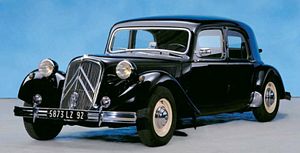|
By accessing or using The Crittenden Automotive Library™/CarsAndRacingStuff.com, you signify your agreement with the Terms of Use on our Legal Information page. Our Privacy Policy is also available there. |

The Global Appeal Of Front Wheel Drive
|
|---|
|
|
The Global Appeal Of Front Wheel Drive
Geoff Maxted
DriveWrite
September 26, 2013
In the 1950’s an automotive genius called Alec Issigonis looked up from his drawing board and said to the assembled company, ‘You know, if we just turn the engine around sideways…’. It may not have gone quite like that but, whatever, the Mini was born and front wheel drive began its domination of the world of motor cars in the modern era.
Of course, FWD has been around for almost as long as cars have. The beautiful Citroen Traction Avant in the image is an example and there were plenty of others. Alfa Romeo developed the ‘33’ (unrelated to the other ‘33’ models) as a front wheel drive offering that resembled a smaller Guilia of the time, but sadly it never saw production. Had it been made it would have preceded the Mini by about five years.
Front-wheel drive dominates today’s automotive landscape, powering everything from city cars and hatchbacks to full-size SUVs. Post war, rear-wheel drive ruled - indeed that’s all there was - and even today some car makers still have a preference for it. Certainly, dedicated drivers will tell you that they prefer RWD because they feel, not without some justification, that RWD makes for better, more balanced, handling and improved grip. Nevertheless, for the mass market FWD will do nicely.
Fuel economy was the first priority but that’s a tentative argument. In fact, it was simply packaging that promoted FWD to the masses. The decision to build the Mini was a prescient one as it turns out. Over the last fifty years it has allowed car makers to build cars that are smaller and lighter. This is why they have better economy, not because of any particular engineering technicality.
In a typical front-engine, rear-drive car the transmission tends to eat up a lot of interior space and that becomes a big issue on small cars that have limited cabin space. Eliminating the prop-shaft solved the problem at a stroke and also removed some weight from the motor. Similarly, by getting rid of the rear axle it allowed designers to get a bigger boot from a smaller space. It’s that simple.
Thanks to modern car building technology the switch to front-wheel drive coincided with the move away from ‘the body on a frame’ assembly to lighter unibody construction, a change that dramatically cut the mass of cars. Today’s cars simply do not need to be heavy to be safe. Add to that the huge improvement in engine development coupled with the fact that engines are getting physically smaller and smaller thanks to turbo technology.
It is unlikely that FWD will ever have the same kudos as RWD which, for purists, remains the better driving system but the huge majority of car buyers couldn’t give a fig about that. All they want is a small economical car that will be reliable and economical. We can thanks Issigonis and our motoring forebears for that.



















